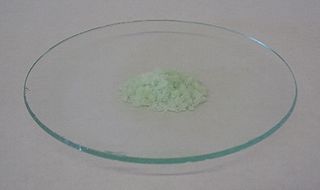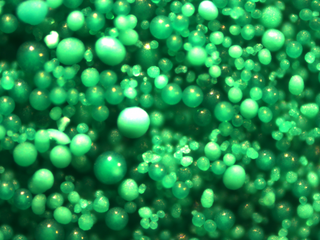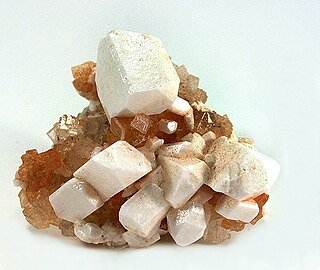Related Research Articles
In chemistry, a salt is a chemical compound consisting of an ionic assembly of positively charged cations and negatively charged anions, which results in a compound with no net electric charge. A common example is table salt, with positively charged sodium ions and negatively charged chloride ions.

Vulcano or Vulcan is a small volcanic island belonging to Italy in the Tyrrhenian Sea, about 25 km (16 mi) north of Sicily and located at the southernmost end of the seven Aeolian Islands. The island is 21 km2 (8 sq mi) in area, rises to 501 m (1,644 ft) above sea level, and it contains several volcanic calderas, including one of the four active volcanoes in Italy that are not submarine.

Ammonium chloride is an inorganic compound with the formula NH4Cl and a white crystalline salt that is highly soluble in water. Solutions of ammonium chloride are mildly acidic. In its naturally occurring mineralogic form, it is known as sal ammoniac. The mineral is commonly formed on burning coal dumps from condensation of coal-derived gases. It is also found around some types of volcanic vents. It is mainly used as fertilizer and a flavouring agent in some types of liquorice. It is the product from the reaction of hydrochloric acid and ammonia.

Jarosite is a basic hydrous sulfate of potassium and ferric iron (Fe-III) with a chemical formula of KFe3(SO4)2(OH)6. This sulfate mineral is formed in ore deposits by the oxidation of iron sulfides. Jarosite is often produced as a byproduct during the purification and refining of zinc and is also commonly associated with acid mine drainage and acid sulfate soil environments.
Classical qualitative inorganic analysis is a method of analytical chemistry which seeks to find the elemental composition of inorganic compounds. It is mainly focused on detecting ions in an aqueous solution, therefore materials in other forms may need to be brought to this state before using standard methods. The solution is then treated with various reagents to test for reactions characteristic of certain ions, which may cause color change, precipitation and other visible changes.

A double salt is a salt that contains more than one different cation or anion. Examples of double salts include alums (with the general formula MIMIII[SO4]2·12H2O) and Tutton's salts (with the general formula [MI]2MII[SO4]2·6H2O). Other examples include potassium sodium tartrate, ammonium iron(II) sulfate (Mohr's salt), and bromlite. The fluorocarbonates contain fluoride and carbonate anions. Many coordination complexes form double salts.

Millosevichite is a rare sulfate mineral with the chemical formula Al2(SO4)3. Aluminium is often substituted by iron. It forms finely crystalline and often porous masses.
Friedel's salt is an anion exchanger mineral belonging to the family of the layered double hydroxides (LDHs). It has affinity for anions as chloride and iodide and is capable of retaining them to a certain extent in its crystallographical structure.
Eudialyte group is a group of complex trigonal zircono- and, more rarely, titanosilicate minerals with general formula [N(1)N(2)N(3)N(4)N(5)]3[M(1a)M(1b)]3M(2)3M(4)Z3[Si24O72]O'4X2, where N(1) and N(2) and N(3) and N(5) = Na+ and more rarely H3O+ or H2O, N(4) = Na+, Sr2+, Mn2+ and more rarely H3O+ or H2O or K+ or Ca2+ or REE3+ (rare earth elements), M(1) and M(1b) = Ca2+, M(1a) = Ca2+ or Mn2+ or Fe2+, M(2) = Fe (both II and III), Mn and rarely Na+, K+ or Zr4+, M(3) = Si, Nb and rarely W, Ti and [] (vacancy), M(4) = Si and or rarely [], Z Zr4+ and or rarely Ti4+, and X = OH−, Cl− and more rarely CO32− or F−. Some of the eudialyte-like structures can even be more complex, however, in general, its typical feature is the presence of [Si3O9]6− and [Si9O27]18− ring silicate groups. Space group is usually R3m or R-3m but may be reduced to R3 due to cation ordering. Like other zirconosilicates, the eudialyte group minerals possess alkaline ion-exchange properties, as microporous materials.

Dicopper chloride trihydroxide is the chemical compound with the formula Cu2(OH)3Cl. It is often referred to as tribasic copper chloride (TBCC), copper trihydroxyl chloride or copper hydroxychloride. It is a greenish crystalline solid encountered in mineral deposits, metal corrosion products, industrial products, art and archeological objects, and some living systems. It was originally manufactured on an industrial scale as a precipitated material used as either a chemical intermediate or a fungicide. Since 1994, a purified, crystallized product has been produced at the scale of thousands of tons per year, and used extensively as a nutritional supplement for animals.

Green rust is a generic name for various green crystalline chemical compounds containing iron(II) and iron(III) cations, the hydroxide (HO−
) anion, and another anion such as carbonate (CO2−
3), chloride (Cl−
), or sulfate (SO2−
4), in a layered double hydroxide structure. The most studied varieties are
Xitieshanite is a hydrous iron sulfate–chloride mineral with chemical formula: Fe3+(SO4)Cl·6(H2O).

Leonite is a hydrated double sulfate of magnesium and potassium. It has the formula K2SO4·MgSO4·4H2O. The mineral was named after Leo Strippelmann, who was director of the salt works at Westeregeln in Germany. The mineral is part of the blodite group of hydrated double sulfate minerals.
Lucabindiite is a mineral discovered in 1998 from the La Fossa crater at Vulcano, the Aeolian islands off the coast of Italy. It has the chemical formula As4O6(Cl,Br) and is hexagonal. After months of collecting sublimates and encrustations, the researchers discovered lucabindiite which was found on the surface of pyroclastic breccia. The mineral is named after Luca Bindi, who was a professor of mineralogy and former head of the Division of Mineralogy of the Natural History Museum of the University of Florence.
The sulfate chlorides are double salts containing both sulfate (SO42–) and chloride (Cl–) anions. They are distinct from the chlorosulfates, which have a chlorine atom attached to the sulfur as the ClSO3− anion.
Potassium fluorosilicate is a chemical compound with the chemical formula K2[SiF6].

Fumarole minerals are minerals which are deposited by fumarole exhalations. They form when gases and compounds desublimate or precipitate out of condensates, forming mineral deposits. They are mostly associated with volcanoes, but have been encountered on burning coal deposits as well. They can be black or multicoloured and are often unstable upon exposure to the atmosphere.
References
- ↑ Warr, L.N. (2021). "IMA–CNMNC approved mineral symbols". Mineralogical Magazine. 85: 291–320.
- ↑ Demartin, Francesco, Carlo Maria Gramaccioli, and Italo Campostrini. "Adranosite,(NH4) 4NaAl2 (SO4) 4Cl (OH) 2, a new ammonium sulfate chloride from La Fossa crater, Vulcano, Aeolian Islands, Italy." The Canadian Mineralogist48.2 (2010): 315-321.
- ↑ "Adranosite: Adranosite mineral information and data". www.mindat.org. Retrieved 2017-12-30.
- ↑ Mitolo, Donatella, et al. "Adranosite-(Fe),(NH4) 4NaFe2 (SO4) 4Cl (OH) 2, a new ammonium sulfate chloride from La Fossa Crater, Vulcano, Aeolian Islands, Italy." The Canadian Mineralogist 51.1 (2013): 57-66.